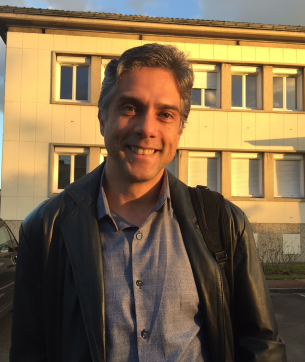Hydropower management in Brazil and water forecasts – Interview with Alberto Assis dos Reis
 Alberto is an engineer and hydrologist at Cemig, a Brazilian power company headquartered in Belo Horizonte, the capital of the state of Minas Gerais, and is currently starting a PhD work at the Federal University of Minas Gerais (UFMG). His PhD project involves also collaboration with three other organizations in Europe, strongly involved in Hepex: Irstea (France), Deltares (The Netherlands) and ECMWF (UK). He was recently visiting these organizations and, when he came to France, I took the opportunity to ask him some questions:
Alberto is an engineer and hydrologist at Cemig, a Brazilian power company headquartered in Belo Horizonte, the capital of the state of Minas Gerais, and is currently starting a PhD work at the Federal University of Minas Gerais (UFMG). His PhD project involves also collaboration with three other organizations in Europe, strongly involved in Hepex: Irstea (France), Deltares (The Netherlands) and ECMWF (UK). He was recently visiting these organizations and, when he came to France, I took the opportunity to ask him some questions:
Maria-Helena Ramos: In a few words, how do you describe the Brazilian electric system?
Alberto Assis dos Reis: Currently, the system has an installed capacity of about 152 GW, the largest in South America, and it is essentially hydrothermal, with a great part of hydraulic generation (nearly 65% of domestic supply). In fact, Brazil has an electric matrix that is predominantly of renewable sources (74.6% of the electricity of domestic supply), including an important share of biomass (from sugar cane) and wind power. By 2024, it is expected that hydropower and biomass relative part will slightly decrease, although they will remain important sources of power generation. Wind power and solar power are expected to increase their part in the Brazilian electricity generation in the near future.
Today, the system is regulated by the “Operator of the National Electricity System” (ONS), which is a non-profit private entity created in 1998. The ONS is responsible for the coordination and control of the generation and transmission installations in the National Interconnected System (SIN). The SIN comprises the electricity companies in the South, South-East, Center-West, North-East and part of the North region, including Cemig, the company I have been working for since 2002.
MHR: How important are streamflow forecasts to the management of hydropower production in Brazil?
AAR: Brazil has a large capacity for water storage; I think it is one of the greatest, if not the greatest, in the world. The inflows to hydroelectric plants have a considerable weight in the planning of the operation of the electrical system, as well as a large weight in the energy price setting in the short term market, the SDP – Settlement of Differences Price.
The calculation of the SDP is based on what we call MCO – Marginal Cost of Operation, which is limited by a minimum and a maximum price, both set annually by the NEEA – National Electric Energy Agency (in Portuguese, Agência Nacional de Energia Elétrica, ANEEL). The MCO is obtained from computer models run by the ONS. These models optimize the system’s operation, solving the hydrothermal dispatch problem in Brazil.
These models run once a week, every Thursday, with flow forecasts. Forecasts are issued on a weekly basis for the first five weeks and on a monthly basis for the next months. Currently, hydrologic models are used for the first week, ARMA models are used for the following weeks, and synthetic flow series are generated for up to 5 years, based on historic flow records from 1931 to today.
Streamflow flow forecasts and reservoir levels are variables with a strong role as price definers. It is estimated that they account for about 60% of the price definition. It is thus important to have hydrologic forecasts of good quality when taking decisions on selling and buying energy in the market.
MHR: Why have you decided to do a PhD work on ensemble forecasting?
AAR: It is a long story! At Cemig, we have been working on the development of robust seasonal forecasting system for several years. Our aim is to have an efficient operation of the hydropower plants with state-of-the-art products. We have been using medium-range ensemble weather forecasts (up to 15 days) and the ESP (Ensemble Streamflow Prediction) technique with a hydrological model operated in house, calibrated for a large set of catchments in Brazil.
As you know, the operationalization of hydrologic ensemble modeling is a fairly laborious activity to perform manually, because it means repeating several times the data collection activities, the preparation of files for models and their application in hydrological models. We have thus put efforts into the development of tools to automate this process. Since 2014, in collaboration with Deltares and LACTEC, we have the FEWS-Cemig system running, now in operational mode, over 40 operational centers of water forecast.
I have been involved in this project since the beginning and now that everything is running more or less automatically I have more time to spend on experting the forecasts. This means that I have more ideas on how to improve them! I am curious to know if we can improve our systems and make even better forecasts. I am also interested in running a seamless forecasting system, from short- to long-range forecasts in a coherent, and unique, framework.
That’s why I decided to do a PhD work: to explore further techniques to improve the quality of the forecasts in a seamless system and evaluate its impact on the management of hydropower reservoirs. I think this can be a great advantage for us, at Cemig, opening up a range of potential applications as a support tool for decision in the Brazilian scenario of water modeling.
Thank you, Alberto, for this interview and all the best for this exciting PhD work!
0 comments